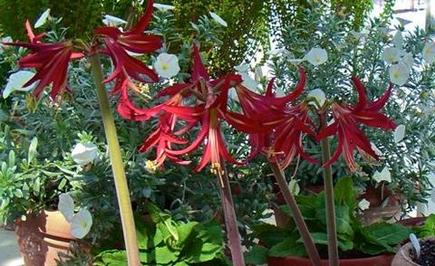Of Bulbs and Bon Bons

I had an unexpected stroke of luck this year. I would like to say it was a stroke of genius, but that would be disingenuous.
Last winter, I bought several pots of forced hyacinths. When they were finished blooming, I tucked them out of sight until it was spring when I planned to plant them in the garden, but I forgot all about them. Then, in January, I came across them again. They were outside where they’d been since March, unprotected from the elements, and in spite of a lack of sunlight, they were coming up in one of our extended winter thaws. Not only were the leaves emerging, but they were also beginning to bloom. Delighted, I rushed them inside where they bloomed for the better part of a month, filling the house with the promising smell of spring.
Even though there are daffodils, crocus, and snowdrops blooming outside now, some disconcertingly early, I wish I had more bulbs waiting to be brought in and coaxed into bloom. If I had a bulb cooler (think meat locker with shelves instead of hooks), I would force all kinds of bulbs. I would spend the doldrums of August scouring bulb catalogues for tips on the best cultivars for forcing and then order them in quantity. As soon as they arrived in mid-fall, and before they could spoil, I’d pot them up in good sized terracotta pots (my preference, not mandatory) with drainage holes and a minimum of 6 inches of planting depth – the deeper the better for root development, especially for bigger bulbs. I might even plant a few in old wine crates lined with heavy plastic, though I’d have to remember not to overwater them since they wouldn’t drain. I’d cover the smaller bulbs with a thin layer of soil, and leave the tops of the larger bulbs poking out slightly, making sure that they didn’t touch each other or the sides of the pots.
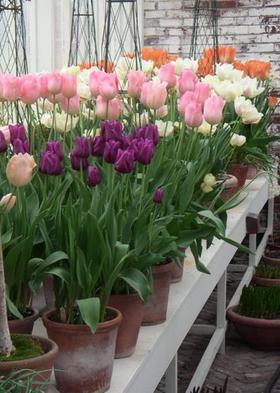
I’d use a light potting medium that wouldn’t get water logged, and I’d fertilize the bulbs with a bit of 20-20-20 fertilizer, to give them a little boost. I’d tuck them in the in the back of the bulb locker where I could check them every week to be sure they hadn’t dried out. Absent the locker, you could keep them in a cold garage, cold frame, or loosely wrapped in a plastic bag in the fridge – anywhere they’d be cold but not frozen, moist but not soggy, and well protected from freeloading, hungry rodents. Then after the requisite cold period, I’d put them in a slightly warmer place until their leaves began to emerge so that their flowers could develop slowly and completely. From painful experience, I know that rushing this process can result in stunted flowers. When the leaves had grown and the tops of the buds had appeared, I would bring them in and wait for them to burst into glorious bloom.
I would have dozens of pots of tulips, of course, all different species, colors and sizes – a mini Keukenhof! Instead of counting my diamonds and eating bon bons, I’d count my tulips and eat bon bons. Tulips need a deepish pot for their roots, and most need a good 14-16 weeks of cold before they will bloom.
Grape hyacinths (Muscari) would also be mandatory. I adore their blues, blue blacks, whites, and other permutations, and many people appreciate the fact that they are not as overwhelmingly fragrant as real hyacinths. They are most beautiful in masses, so I’d find wide, shallow pots, (maybe 6-8 inches deep) and would pack them with as many bulbs as I could. They’d be in the cooler for about 10 weeks and when they were finished blooming, I would plant them in a sunny spot in the garden where they would send their leaves up again in the fall, as grape hyacinths habitually do, and bloom again in a year or two.
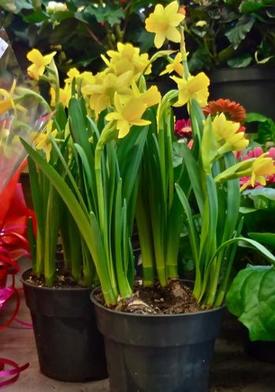
While you can force many kinds of daffodils, the smaller varieties, like “Tete a Tete” daffs, are great because they are well scaled for a small urban garden and can be easily planted outside when they are finished blooming. Besides, if spring is about yellow then, these are must-haves. They will need a 12-14 week cool period.
I’d also have to have spring star flower (Ipheion uniflorum), a member of the onion family. I first saw starflower in a greenhouse where it had been forced to bloom. I lost my heart to it’s icy blue flowers and, subsequently, to the white and darker blue versions, in spite of its faint oniony smell. It needs 10-12 weeks of cold, and will come into bloom about three weeks after being brought inside. Put them near the muscari in the garden for a beautiful contrast.
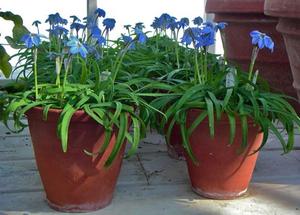
Inexplicably, Spanish bluebells (Hyacinthoides hispanica) are less commonly forced, but are stunning in pots. While we often think of bluebells as, well, blue, we might try the white or the pink ones. Growing taller than grape hyacinths and
spring starflower, their strappy leaves and bobbing bell-shaped flowers would be a perfect complement to our indoor collection of flowering bulbs.
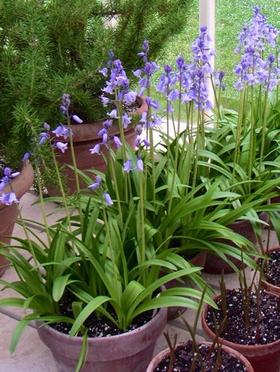
Once planted in the garden, Spanish bluebells will bloom in mid spring, though like many bulbs that have been forced, it may take a year or two before they will bloom again.
We could also force bulbs that don’t need a cold period, like freesias. These sweetly scented South African natives come in a host of colors, and need to be warmed rather than cooled, so put them somewhere nice and toasty but not too bright, (a heated floor is perfect) and keep them barely moist for two months or so. When the leaves are a couple of inches high, the pots can be moved to a cooler spot – cooler so they will last longer. Freesias need to be staked even more than paper whites do. I love using the twiggy cuttings of dark shrubs cut in 36-inch lengths and pushed in among the corms. It’s a much tonier look than bamboo stakes and twine.
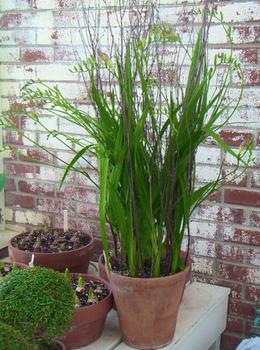
Of course, we’d have to have amaryllis (Hippeastrum). We’d to try something exotic, like one of the South American Hippeastrum cybister hybrids. I love their narrow strappy petals and their delicate structure. Tender amaryllis should be left in the pot and fertilized regularly until fall. Amaryllis needs a dormant period to bloom again, so before the first frost, cut off all the remaining foliage. Remove the bulbs from the pots, wash them off, and store in a dry, cool (not freezing) place for 5-6 weeks before repotting and beginning the cycle again.
I can’t wait for the bulb catalogues to come out so I can plan my indoor bulb display for next winter. If I am successful, I will be able to claim genius credibly and have lots of blossoms to count while eating my bon bons!
